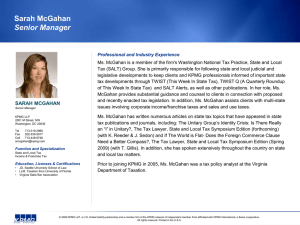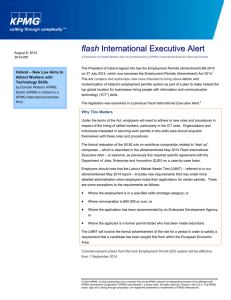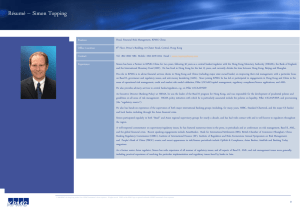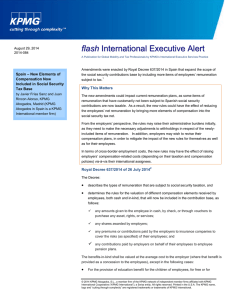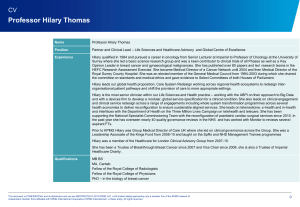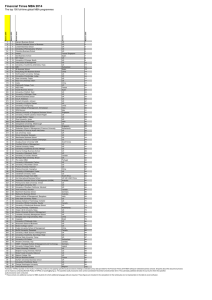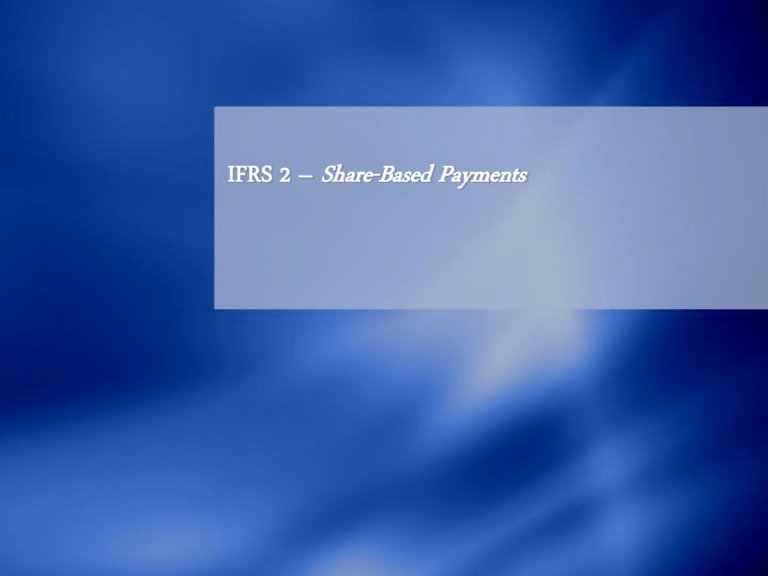
IFRS 2 – Share-Based Payments
© [year] [legal member firm name], a [jurisdiction] [legal structure] and a member firm of the KPMG network of independent member firms affiliated with KPMG International, a Swiss cooperative. All rights reserved. Printed in
[country in which the publication will be printed].
FOR INTERNAL USE ONLY
1
Agenda
♦ Overview of share-based payments
♦ Equity-settled transactions – Employees
♦ Other share-based payment issues
© [year] [legal member firm name], a [jurisdiction] [legal structure] and a member firm of the KPMG network of independent member firms affiliated with KPMG International, a Swiss cooperative. All rights reserved. Printed in
[country in which the publication will be printed].
FOR INTERNAL USE ONLY
2
IFRS 2 – Objective and scope
♦ Objective and rationale:
− Reflect in profit or loss and the statement of financial
position the effects of share-based payment
transactions
• Entity has received goods or services as consideration for
equity-settled or cash-settled share-based payments
• Objective is to recognise and measure fair value of goods or
services received
© [year] [legal member firm name], a [jurisdiction] [legal structure] and a member firm of the KPMG network of independent member firms affiliated with KPMG International, a Swiss cooperative. All rights reserved. Printed in
[country in which the publication will be printed].
FOR INTERNAL USE ONLY
3
IFRS 2 – Objective and scope (continued)
Share-based
payments
Equitysettled
share-based
payments
Cash-settled
share-based
payments
Share-based
payments
with cash
alternatives
Entity receives
goods/services as
consideration for
equity
instruments.
Entity receives
goods/services by
incurring a liability to
transfer cash or
other assets to the
supplier for amounts
that are based on
the price (or value)
of the entity’s
shares.
Either entity or the
counterparty has a
choice to settle in
equity instruments
or in cash or other
assets.
© [year] [legal member firm name], a [jurisdiction] [legal structure] and a member firm of the KPMG network of independent member firms affiliated with KPMG International, a Swiss cooperative. All rights reserved. Printed in
[country in which the publication will be printed].
FOR INTERNAL USE ONLY
4
IFRS 2 – Objective and scope (continued)
♦ Share-based payment transactions include:
− Grants to employees (and others providing similar
services, e.g. non-executive directors)
− Grants to non-employees, e.g. consultants, suppliers
− Employee share purchase plans
− Certain share-based payments settled by an entity in,
or an external shareholder of, the same group
© [year] [legal member firm name], a [jurisdiction] [legal structure] and a member firm of the KPMG network of independent member firms affiliated with KPMG International, a Swiss cooperative. All rights reserved. Printed in
[country in which the publication will be printed].
FOR INTERNAL USE ONLY
5
IFRS 2 – Objective and scope (continued)
♦ Scope exemption:
− Equity instruments issued as consideration in
business
combination (IFRS 3)
• refer Developments for replacement rewards amendment
− Commodity contracts that can be settled by exchanging
financial instruments and that are not for the purpose of
entity’s expected purchase, sale or usage (IAS 32/39)
© [year] [legal member firm name], a [jurisdiction] [legal structure] and a member firm of the KPMG network of independent member firms affiliated with KPMG International, a Swiss cooperative. All rights reserved. Printed in
[country in which the publication will be printed].
FOR INTERNAL USE ONLY
6
Timeline of a share option award
Vesting period - the period
during which all the specified
vesting conditions are to be
satisfied
Vesting period
Year 1
Year 2
Year 3
Time
Grant
date
Grant date - the date at
which the entity and
the counter party have a
shared understanding of
the terms and conditions
of the arrangement
Vesting
date
Vesting date – the date
when the vesting conditions
for entitlement are satisfied
Exercise
date
Exercise date is the date
when awards (e.g. options)
are exercised.
© [year] [legal member firm name], a [jurisdiction] [legal structure] and a member firm of the KPMG network of independent member firms affiliated with KPMG International, a Swiss cooperative. All rights reserved. Printed in
[country in which the publication will be printed].
FOR INTERNAL USE ONLY
7
General recognition principles
♦ Debit
− Recognise goods / services received when goods are
obtained or services are received
− When the goods / services do not qualify for recognition
as assets, an expense is recognised
♦ Credit
− For equity-settled share-based payment transactions a
corresponding increase in equity is recognised; and
− For cash-settled share-based payment transactions a
corresponding liability is recognised
© [year] [legal member firm name], a [jurisdiction] [legal structure] and a member firm of the KPMG network of independent member firms affiliated with KPMG International, a Swiss cooperative. All rights reserved. Printed in
[country in which the publication will be printed].
FOR INTERNAL USE ONLY
8
General recognition principles (continued)
♦ IFRS 2 contains specific requirements for:
− Equity-settled (shares, options, warrants)
− Cash-settled (share appreciation rights, puttable
shares, options on puttable shares)
− Choice between equity and cash-settled (depends on
who has choice, entity or counterparty (i.e. employee
or non-employee))
© [year] [legal member firm name], a [jurisdiction] [legal structure] and a member firm of the KPMG network of independent member firms affiliated with KPMG International, a Swiss cooperative. All rights reserved. Printed in
[country in which the publication will be printed].
FOR INTERNAL USE ONLY
9
General measurement principles
General measurement principles
Equity-settled
share-based
payments
Cash-settled
share-based
payments
Non-employees
Employees
Goods/services are
measured directly,
based on fair value
of goods/services
received.
Goods/services are
measured
indirectly, by
reference to fair
value of equity
instruments
granted.
If not reliably
measurable
(only in rare cases)
Goods/services are
measured at the
intrinsic value of
the equity
instruments.
Goods/services are
measured at the
grant date fair value
of the liability.
Liability is
remeasured.
If not reliably
measurable
(only in rare cases)
© [year] [legal member firm name], a [jurisdiction] [legal structure] and a member firm of the KPMG network of independent member firms affiliated with KPMG International, a Swiss cooperative. All rights reserved. Printed in
[country in which the publication will be printed].
FOR INTERNAL USE ONLY
10
Agenda
♦ Overview of share-based payments
♦ Equity-settled transactions – Employees
− Determining fair value
− Accounting for employee services received
• Overview of conditions
• Modified grant date method
− Measurement illustrations
♦ Other share-based payment issues
© [year] [legal member firm name], a [jurisdiction] [legal structure] and a member firm of the KPMG network of independent member firms affiliated with KPMG International, a Swiss cooperative. All rights reserved. Printed in
[country in which the publication will be printed].
FOR INTERNAL USE ONLY
11
Determining the fair value of equity
instruments granted
♦ Fair Value
− Measure employee services indirectly, based on fair value
of equity instruments granted
− Fair value of equity instruments measured at market price
for instruments with similar terms and conditions (rarely
available)
− If no market exists, fair value is estimated by applying a
valuation (e.g. option pricing) model
− If fair value is not measurable reliably (only in very rare
cases), then services are measured at the intrinsic value of
the equity instruments
♦ Date of measurement
− Fair value measured at grant date
© [year] [legal member firm name], a [jurisdiction] [legal structure] and a member firm of the KPMG network of independent member firms affiliated with KPMG International, a Swiss cooperative. All rights reserved. Printed in
[country in which the publication will be printed].
FOR INTERNAL USE ONLY
12
Accounting for employee services received
*
If no vesting conditions
*
If vesting conditions
recognise immediately
credit equity
spread over vesting period
credit equity incrementally
apply “modified grant date method”
© [year] [legal member firm name], a [jurisdiction] [legal structure] and a member firm of the KPMG network of independent member firms affiliated with KPMG International, a Swiss cooperative. All rights reserved. Printed in
[country in which the publication will be printed].
FOR INTERNAL USE ONLY
13
Accounting for employee services received
(continued)
Overview of conditions
♦ Conditions
− Vesting conditions are service related, i.e. they determine
whether the entity receives the services that entitle the
counterparty to the share-based payment
− Service conditions; with or without …
− Performance conditions
» Market performance conditions or
»
non-market performance conditions
Performance conditions by definition always require
a service condition
− Non-vesting conditions are not service related, i.e. they do
not determine whether the entity receives the services that
entitle the counterparty to the share-based payment
© [year] [legal member firm name], a [jurisdiction] [legal structure] and a member firm of the KPMG network of independent member firms affiliated with KPMG International, a Swiss cooperative. All rights reserved. Printed in
[country in which the publication will be printed].
FOR INTERNAL USE ONLY
14
Accounting for employee services received
(continued)
Overview of conditions
Vesting
conditions
Service
conditions
Performance
conditions
Market
conditions
Non-market
conditions
Service condition
+
condition that is
related to the
market price of
the equity
instrument
Service condition
+
condition that is a
performance
condition, but not
market price
related
• Share price must
increase by 15%
• TSR (total
shareholder
return) must
increase by 10%
• Revenue must
increase by 10%
• Percentage
increase in
market share
Requirement to
complete a
specified period of
service
• Employee has to
stay employed
for 3 three years
after grant date
© [year] [legal member firm name], a [jurisdiction] [legal structure] and a member firm of the KPMG network of independent member firms affiliated with KPMG International, a Swiss cooperative. All rights reserved. Printed in
[country in which the publication will be printed].
FOR INTERNAL USE ONLY
15
Accounting for employee services received
(continued)
Overview of conditions
Non-vesting
conditions
Conditions
that neither
the entity nor
the
counterparty
can choose to
meet
• Inflation must not
be higher than
5%
• Price of gold
must increase by
more than 3 %
Conditions
that the
counterparty
can choose to
meet
Conditions
that the entity
can choose to
meet
• Holding
participation
shares over the
holding period
• Paying monthly
contributions to a
share purchase
plan
• Continuation of
the plan by the
entity
© [year] [legal member firm name], a [jurisdiction] [legal structure] and a member firm of the KPMG network of independent member firms affiliated with KPMG International, a Swiss cooperative. All rights reserved. Printed in
[country in which the publication will be printed].
FOR INTERNAL USE ONLY
16
Accounting for employee services received
(continued)
“Modified grant date method”
At grant date
Determine transaction amount
Grant date fair
value of an
instrument
x
During vesting period
up to vesting date
• True up for changes in estimate of meeting service
conditions and non-market performance
conditions.
• Do not true up for changes in estimates of meeting
market conditions and non-vesting conditions.
Number of
instruments
expected to
vest
Market
conditions
Service
conditions
Non-vesting
conditions
Non-market
performance
conditions
© [year] [legal member firm name], a [jurisdiction] [legal structure] and a member firm of the KPMG network of independent member firms affiliated with KPMG International, a Swiss cooperative. All rights reserved. Printed in
[country in which the publication will be printed].
FOR INTERNAL USE ONLY
17
Measurement illustration (1) Performance conditions
♦ Vesting conditions:
− Three years continued employment (service condition)
− A performance condition (see next slide)
♦ Assumptions:
− 100 options granted on 1 January 20X1
− All employees remain in service over the vesting period
of the option
− Grant date fair value of each option is 3.50 (excluding
market conditions)
− Best estimate is that the performance condition is met
© [year] [legal member firm name], a [jurisdiction] [legal structure] and a member firm of the KPMG network of independent member firms affiliated with KPMG International, a Swiss cooperative. All rights reserved. Printed in
[country in which the publication will be printed].
FOR INTERNAL USE ONLY
18
Measurement illustration (2) Performance conditions
♦ If market condition, e.g., share price hitting a
specified level
− The estimated discount for market-based performance condition
−
−
is 0.50
Therefore grant date fair value of each option is 3.00 (3.50 - 0.50)
Total compensation cost is 300
Market condition
Expense recognised:
Year 20X1
Year 20X2
100
100
© [year] [legal member firm name], a [jurisdiction] [legal structure] and a member firm of the KPMG network of independent member firms affiliated with KPMG International, a Swiss cooperative. All rights reserved. Printed in
[country in which the publication will be printed].
FOR INTERNAL USE ONLY
19
Measurement illustration (3) Performance conditions
♦ Now, assume that at the end of 20X2 the best estimate becomes
that the market condition will not be met (the target share price
will not be reached).
♦ All service conditions are expected to be met.
Employee service cost of 300 is recognised even if the market
condition is not met (as long as services are provided)
Market condition
Expense recognised:
Year 20X1
Year 20X2
Year 20X3
Total
100
100
100
300
© [year] [legal member firm name], a [jurisdiction] [legal structure] and a member firm of the KPMG network of independent member firms affiliated with KPMG International, a Swiss cooperative. All rights reserved. Printed in
[country in which the publication will be printed].
FOR INTERNAL USE ONLY
20
Measurement illustration (4) Performance conditions
♦ If non-market condition, e.g., certain revenue target
must be met:
− Grant date fair value of each option is 3.50
− Total expected compensation cost is 350
− Allocate over service period based on best estimate of outcome
− Employee service cost is adjusted for any forfeiture
20X1
20X2
Expected total Accumulated
Expensed in
Expense in
compensation
attribution
prior period(s)
current year
cost
350
117
0
117
(350/3)*1
350
233
(350/3)*2
-117
116
© [year] [legal member firm name], a [jurisdiction] [legal structure] and a member firm of the KPMG network of independent member firms affiliated with KPMG International, a Swiss cooperative. All rights reserved. Printed in
[country in which the publication will be printed].
FOR INTERNAL USE ONLY
21
Measurement illustration (5) Performance conditions
♦ Now, assume that at the end of 20X2 the best estimate becomes
that only 50% of employees will meet the performance condition.
All service conditions are expected to be met. This is also the
actual outcome.
Expected total
compensation cost
20X1
350
20X2
350
20X3
175
175
Accumulated
attribution
117
(350/3)*1
117
(175/3)*2
175
(175/3)*3
Expensed in
prior period(s)
Expense in
current year
0
117
-117
0
-117
58
Total
175
© [year] [legal member firm name], a [jurisdiction] [legal structure] and a member firm of the KPMG network of independent member firms affiliated with KPMG International, a Swiss cooperative. All rights reserved. Printed in
[country in which the publication will be printed].
FOR INTERNAL USE ONLY
22
Measurement illustration (6) Performance conditions
♦ Comparison:
A change in the expectation whether or not a performance
condition will be met
• is ignored for market conditions
• but recognised for non-market conditions.
Market condition
Expense recognised:
Year 20X1
Non-market condition
100
117
Year 20X2
100
0
Year 20X3
Total
100
300
58
175
© [year] [legal member firm name], a [jurisdiction] [legal structure] and a member firm of the KPMG network of independent member firms affiliated with KPMG International, a Swiss cooperative. All rights reserved. Printed in
[country in which the publication will be printed].
FOR INTERNAL USE ONLY
23
Measurement illustration (7) Performance conditions
♦ Question:
− What if 50% of the employees left the company at the
end of 20X2? (assuming that this is split equally between
employees that have fulfilled and have not fulfilled the performance
condition)
Market condition
Expense recognised:
Year 20X1
Non-market condition
100
117
Year 20X2
0
-58
Year 20X3
Total
50
150
29
88
© [year] [legal member firm name], a [jurisdiction] [legal structure] and a member firm of the KPMG network of independent member firms affiliated with KPMG International, a Swiss cooperative. All rights reserved. Printed in
[country in which the publication will be printed].
FOR INTERNAL USE ONLY
24
Measurement illustration (8) Performance conditions
♦ Question:
− What if only 80% of the 100 options ultimately are
exercised?
♦ Answer:
− There are no subsequent adjustments after vesting
date for equity-settled share-based payments!
© [year] [legal member firm name], a [jurisdiction] [legal structure] and a member firm of the KPMG network of independent member firms affiliated with KPMG International, a Swiss cooperative. All rights reserved. Printed in
[country in which the publication will be printed].
FOR INTERNAL USE ONLY
25
Agenda
♦ Overview of share-based payments
♦ Equity-settled transactions – Employees
♦ Other share-based payment issues
− Cash-settled transactions
− Equity-settled transactions – non-employees
− Modifications and cancellations
− Implementation issues
− Developments
© [year] [legal member firm name], a [jurisdiction] [legal structure] and a member firm of the KPMG network of independent member firms affiliated with KPMG International, a Swiss cooperative. All rights reserved. Printed in
[country in which the publication will be printed].
FOR INTERNAL USE ONLY
26
Other share-based payment issues
Share-based
payments
Equitysettled
share-based
payments
with
employees
Cash-settled
share-based
payments
Share-based
payments
with cash
alternatives
with nonemployees
© [year] [legal member firm name], a [jurisdiction] [legal structure] and a member firm of the KPMG network of independent member firms affiliated with KPMG International, a Swiss cooperative. All rights reserved. Printed in
[country in which the publication will be printed].
FOR INTERNAL USE ONLY
27
Cash-settled transactions
♦ Results in payment of cash (or other assets) to the
counterparty
♦ Payment is based on value of equity instrument, e.g.,
change in share price
♦ Results in a liability
− Allocate grant date measurement over vesting period
(same approach as equity-settled)
− Remeasure the fair value of the liability at the end of
each reporting period
− Remeasurement recognised in profit or loss
♦ Requirement to remeasure overrides no true up for
market conditions
© [year] [legal member firm name], a [jurisdiction] [legal structure] and a member firm of the KPMG network of independent member firms affiliated with KPMG International, a Swiss cooperative. All rights reserved. Printed in
[country in which the publication will be printed].
FOR INTERNAL USE ONLY
28
Recognition illustration (1) –
Cash-settled transaction
♦ Vesting conditions:
− Three year continued employment (service condition)
− Market-based performance condition
♦ Assumptions:
− 100 share appreciation rights granted on 1 January 20X1
− Best estimate is that all employees remain in service over the vesting
−
period
Grant date fair value of each right is 3.00 (including adjustment for
market condition)
Subsequent estimates of:
fair value
Intrinsic value
End year 20X1
4.00
1.50
End year 20X2
4.25
3.00
End year 20X3
4.50
4.25
Settlement date
4.00
4.00
© [year] [legal member firm name], a [jurisdiction] [legal structure] and a member firm of the KPMG network of independent member firms affiliated with KPMG International, a Swiss cooperative. All rights reserved. Printed in
[country in which the publication will be printed].
FOR INTERNAL USE ONLY
29
Recognition illustration (2) Cash-settled transaction
♦ Assume that all service conditions are fulfilled and that the
vested benefits are settled at the end of year 20X4
Original Remea- Current year Cumulative
grant surement
total
Expense recognised:
Year 20X1
Year 20X2
Year 20X3 (vesting date)
Year 20X4 (settlement)
Total
100
100
100
300
33
50
67
-50
100
133
150
167
-50
400
133
283
450
400
© [year] [legal member firm name], a [jurisdiction] [legal structure] and a member firm of the KPMG network of independent member firms affiliated with KPMG International, a Swiss cooperative. All rights reserved. Printed in
[country in which the publication will be printed].
FOR INTERNAL USE ONLY
30
Equity-settled share-based payments
with non-employees
♦ Measured directly at the fair value of goods and services received
− If the fair value of goods and services cannot be estimated reliably,
measure the fair value of equity instrument
−
If the fair value of the equity instrument granted cannot be estimated
reliably (only in very rare cases), equity instruments are measured at
their intrinsic value
♦ Measured at the date the goods or services are obtained
− As opposed to grant date
− Means “daily” if services are rendered
− Simplification method: “regular intervals”
♦ Expense immediately unless
− Goods or services qualify for capitalisation as asset (e.g. inventory); or
− Vesting conditions exist
• expense when services are rendered over the vesting period
© [year] [legal member firm name], a [jurisdiction] [legal structure] and a member firm of the KPMG network of independent member firms affiliated with KPMG International, a Swiss cooperative. All rights reserved. Printed in
[country in which the publication will be printed].
FOR INTERNAL USE ONLY
31
Modification
♦ When modifications decrease the fair value of the
equity instruments, recognition is based on the
original grant date fair value
− i.e. such modifications are ignored
♦ When modifications increase the fair value of the
equity instruments, recognition is the sum of:
− The original grant date fair value; and
− The incremental fair value
• The incremental fair value is the difference between the fair
value of the modified equity instruments and the original equity
instrument, both measured at the date of modification
© [year] [legal member firm name], a [jurisdiction] [legal structure] and a member firm of the KPMG network of independent member firms affiliated with KPMG International, a Swiss cooperative. All rights reserved. Printed in
[country in which the publication will be printed].
FOR INTERNAL USE ONLY
32
Cancellation
♦ Cancellation or settlement is accounted for as
accelerated vesting
− Recognise immediately the amount that otherwise
would have been recognised over the remainder of the
vesting period
− Cancellations by the employer and by the employee
© [year] [legal member firm name], a [jurisdiction] [legal structure] and a member firm of the KPMG network of independent member firms affiliated with KPMG International, a Swiss cooperative. All rights reserved. Printed in
[country in which the publication will be printed].
FOR INTERNAL USE ONLY
33
Implementation issues
♦ Determination of grant date – when do you have a
shared understanding?
♦ Determination of type of benefit granted – e.g.,
Employee Share Purchase Plans with “hidden”
option features
♦ Classification – can an employer facilitate the sale of
shares and classify as equity-settled transaction?
© [year] [legal member firm name], a [jurisdiction] [legal structure] and a member firm of the KPMG network of independent member firms affiliated with KPMG International, a Swiss cooperative. All rights reserved. Printed in
[country in which the publication will be printed].
FOR INTERNAL USE ONLY
34
Implementation issues (continued)
♦ Counterparty has choice of settlement – valuation of
compound instrument and expense recognition
♦ Share-based payment or employee benefit
♦ Recharge arrangements
© [year] [legal member firm name], a [jurisdiction] [legal structure] and a member firm of the KPMG network of independent member firms affiliated with KPMG International, a Swiss cooperative. All rights reserved. Printed in
[country in which the publication will be printed].
FOR INTERNAL USE ONLY
35
Contact details
Pravin Tulsyan
98184 95674
© [year] [legal member firm name], a [jurisdiction] [legal structure] and a member firm of the KPMG network of independent member firms affiliated with KPMG International, a Swiss cooperative. All rights reserved. Printed in
[country in which the publication will be printed].
FOR INTERNAL USE ONLY
36



